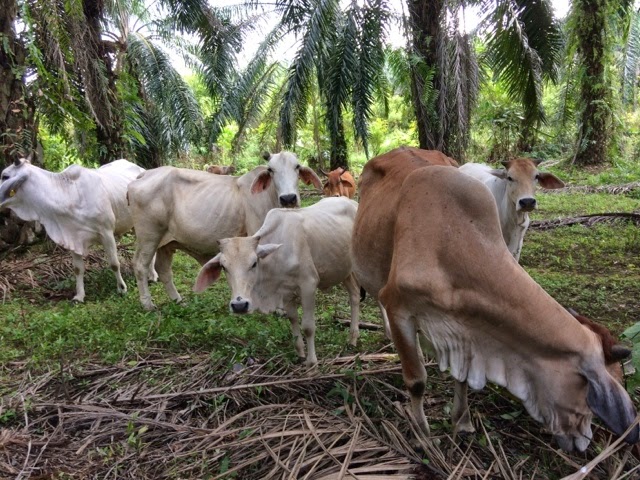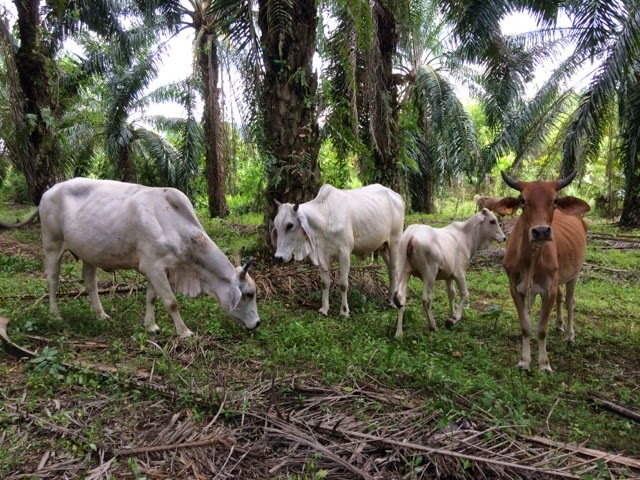A BLOG CREATED TO PROMOTE NETWORKING AMONG LIVESTOCK PRODUCER/SUPPLIER, CONSUMER AND VETERINARIAN
Sunday, December 7, 2014
Cattle Abattoir in Perth
Tuesday, October 7, 2014
Aidiladha: 1,200 Ekor Lembu Habis Ditempah
Tuesday, September 9, 2014
Monday, September 8, 2014
Saturday, September 6, 2014
Bali Cattle in Serian
The banteng (/ˈbæntɛŋ/), Bos javanicus, also known as tembadau, is a species of wild cattle found in Southeast Asia.
Banteng have been domesticated in several places in Southeast Asia, and there are around 1.5 million domestic banteng, which are called Bali cattle. These animals are used as working animals and for their meat.[3] Banteng have also been introduced to Northern Australia, where they have established stable feral populations.[4
Tuesday, July 29, 2014
Monday, July 28, 2014
No buffalo, no Adan rice, so be ‘dung’ with it
BA KELALAN: Buffalo dung is a common sight in Ba Kelalan where its musky smell permeates and lingers in the cold morning air.
An outsider would wonder why the Lun Bawang community, known for their gentleness and refined manner would leave the animals, with their backswept horns, roaming freely on the range.
On closer look, the buffalo herd here does more than just discharge publicly on the road or dotting all the small concrete trails linking houses here, that the visitor might do well to dodge.
“Buffaloes are important to us. Without the buffaloes, we can’t produce the Adan rice that we are having now,” village chief of Long Muda Yudan Meru told the BAT IV team yesterday.
Every year after harvest between January and February, the paddy field will be left to lie fallow. During this time, buffaloes will be free to roam in the paddy field to ‘till’ the land as they trample on it leisurely while grazing on whatever is left after harvesting.
At the same time while ‘tilling’ and ‘clearing’, buffaloes also enrich the paddy fields with their dung. Adan rice is thus fully organic.
It is a natural cycle that has been taking place for hundreds of years and the Lun Bawang community has incorporated that natural cycle into their way of life.
For Yudan who has three plots of paddy fields of about two acres, two buffaloes are enough to execute the job. Buffalo dung is never a nuisance to the Lun Bawang community here, and so too it should be viewed by visitors. The Asian ox is, if anything, treated with quiet reverence.
The Adan rice would not taste as it is without the ubiquitous buffalo and its rich manure. And without Adan Rice, the Lun Bawang community will lose one of its distinctiveness and the main source of income.
The rice strain, according to Yudan, originated from Indonesia. It was the choice of the Lun Bawang forefathers, after testing many other rice species, stuck with it for its higher yield and the best texture. It is called as such after one of their ancestors by the name of ‘Adan’.
“Bario rice is actually Adan rice. They took the seeds from us. It is just that the Kelabit community managed to market it better than us. Now, Bario rice is more famous than Adan Rice and fetches better price. So if we want to fetch more, we have to packet our Adan rice as Bario rice,” said Yudan.
The cycle of planting must follow that the dates set by their ancestors – one that follows the rhythm of nature. After harvesting between January and February, the land will be left to lie fallow until Aug 9. Meanwhile, a nursery has to be prepared in July for transplanting of the seedlings in August. There can only be one crop each year. Any mess-up of the dates will result in scanty yield and poor harvest.
“For example, transplanting must be done from Aug 9 onwards and not earlier. A few families tried to start their nursery earlier and planting early. (And) Their crop ended up not growing well and yielded only half of what we usually harvested.
“That is why everyone now follows the dates set by our ancestors, whom we believe have tested everything and handed to us their most precious experience,” said Supang Gatum, 47, who has moved to Miri and has been employing farm hands to work her paddy field in Ba Kelalan.
Different from Bario, there is still quite a high number of young people staying put in Ba Kelalan. Young farm hands are not difficult to source locally and Adan rice planting is still vibrant, constituting to be the main income earner for the Ba Kelalan.
Supang, who has four plots of land, is able to harvest more than 60 gunny sacks of Adan rice. She will keep about 10 of them for her family’s consumption while the rest will be sold as premium rice in Miri.
From The Borneo Post
Read more: http://www.theborneopost.com/2014/07/28/no-buffalo-no-adan-rice-so-be-dung-with-it/#ixzz38kFGVaSV
Buffalo Farming In Ba Kelalan
BA KELALAN: Buffaloes are highly prized animals for the Lun Bawang community in Ba Kelalan.
According to Lun Bawang elder, Tagal Paran, besides being used to carry logs, buffaloes in Ba Kelalan are normally used to till the land, for meat and for dowry.
“The buffaloes that we tamed can be used for hard labour such as carrying logs from the jungle. I remember that I would not be able to build my house if not for the buffaloes,” he told BAT IV at his residence yesterday.
Tagal, who is fondly known as Pak Tagal among the local community, said buffaloes play a very crucial role in the paddy fields as well.
“In the paddy fields, the buffaloes are let to roam and stay in the paddy fields after cultivation. The buffaloes will eat the grass, paddy straws and help to fertilise the soil with their dung.”
He said unlike the hardship that the local people faced in managing their paddy fields when not many buffaloes were available in 1960s, the people now were much more “relaxed” because most works were done by these beasts of burden.
“In the 1960s, it took the farmers two months to clear the paddy fields to prepare for the next planting season. With the buffaloes around, it will only take the farmers two weeks. That’s why many people are rearing buffaloes here now.”
Tagal said a male buffalo weighing more than 100 kg could be sold for between RM1,800 and RM2,000 in Ba Kelalan, adding that a 200kg buffalo could fetch a price of up to RM4,000.
Meanwhile, Tagal is also a pioneer in rearing horses in Buduk Nur in Ba Kelalan.
He has three horses, with the first one bought from Tuaran, Sabah while the other two were purchased from nearby Bario.
“The horse I bought in Tuaran, Sabah was used for horse racing in Kota Kinabalu. The other two were bought from Bario. When Tan Sri Harris Salleh was Sabah chief minister, he gave six horses to Bario.
“The horses then multiplied and subsequently I bought from them to be reared here in Ba Kelalan.”
Tagal said he initially used the horses as a tourism product but they had turned rather wild as they were let to roam free in the village.
“Nobody dares to ride them now. A year after I bought the horses, an English girl came and rode one of the horses to all the nine villages in Ba Kelalan.”
Read more: http://www.theborneopost.com/2014/07/28/buffaloes-are-multi-tasking-animals-for-lun-bawangs-community/#ixzz38kD8flR9
Friday, July 25, 2014
Cattle Greenlot Model in Oil Palm
Integration Tree Crop Ruminant System concept is to focus on husbandry of breeder cattle and to grow the best local livestock for future Feedlot stock. “Integrasi” is the concept of planting Palm Oil trees to provide secured and healthy environment for breeding female species. Palm Oil leaves supply important food to cattle. Using greenlot system more cattle can be put in the plantation.
Cattle , weighing between 200-250kg will be transfer to Feedlot Farm for food concentration and slaughtering.
Wednesday, June 18, 2014
Tuesday, June 10, 2014
Cattle-oil palm integration in Sarawak
The cattle-oil palm integration programme implemented by the Agriculture Department Sarawak has been successful in increasing the cattle population in the State. Since its implementation in year 2000, the programme has been able to increase the standing population of cattle in the 37 participating estates to10,290 heads. This represents fifty-five percent of the total cattle population in the State of 18,578 heads.
The programme, which now comes under NKEA Agriculture - Entry Point Project No. 5 (EPP 5), will continue to be the major strategy towards increasing beef cattle production in Sarawak. In this regard, PEMANDU has also agreed to extend the programme to estates larger than 15,000 hectares. That decision will allow more oil palm estates to participate in the programme, potentially bringing in an additional 250,000 hectares of estate land for cattle production, or the equivalent of an additional 45,000 heads of cattle.
Thursday, June 5, 2014
Sarawak moots integrated farming route to becoming beef hub
KUCHING, June 5 — The Sarawak government is mulling cooperating with oil palm estates for an integrated farming system to increase cattle population in the state with the goal of becoming a net exporter of beef.
Deputy Chief Minister Tan Sri Alfred Jabu said Sarawak has over 400,000 hectares are suitable for cattle integration projects. But so far only about 80,000 hectares with about 10,500 cattles were being used for that purpose.
“To increase the cattle population, the Sarawak government would be focusing on the integrated farming system with oil palm plantations. The potential is there and I would like to work with oil palm estates,” Jabu told reporters after officiating at the First Asean Regional Conference on Animal Production (ARCAP) 2014 here today.
Jabu who is also the state Minister of Modernisation of Agriculture, said assuming that five hectares could support one adult cattle for one year, then the 400,000 hectares of oil palm plantations in Sarawak alone has the potential of supporting more than 80,000 heads of cattle.
“If all the oil palm plantations practice this integrated farming maybe Sarawak can even be a net exporter of beef,” he added.
Jabu added that the state’s agricultural waste and residue could provide an alternative supply for livestock feed.
He also advised farmers in the state to be more knowledgeable and keep abreast with the latest technologies and development of agricultural practices as consumers are becoming more selective, demand high quality and safer food.
From The Malay Mail Online.


















































